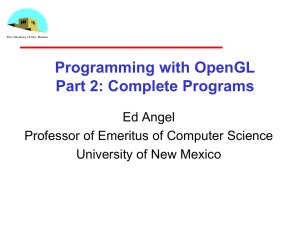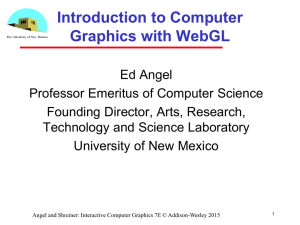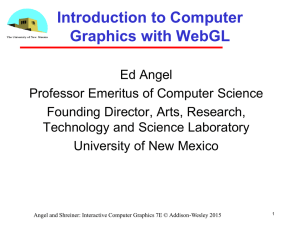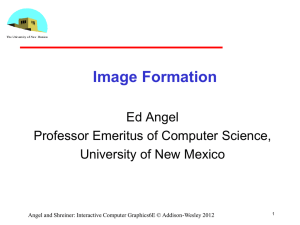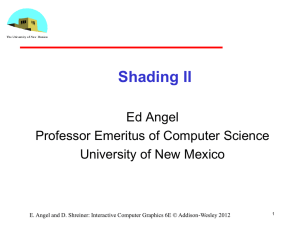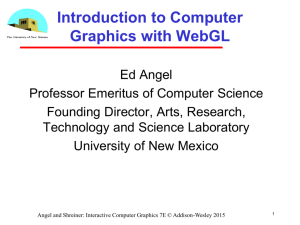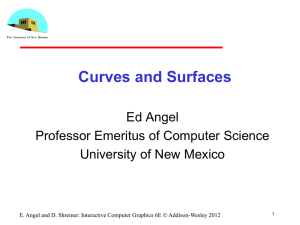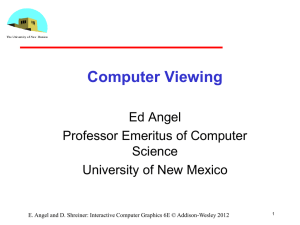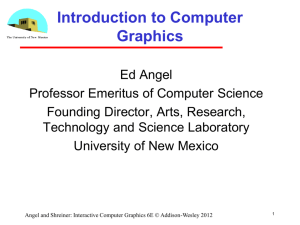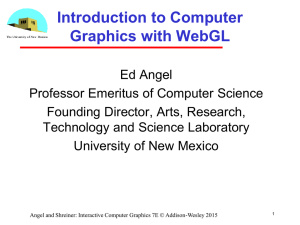Angel_UNM_14_1_3 - Computer Science
advertisement
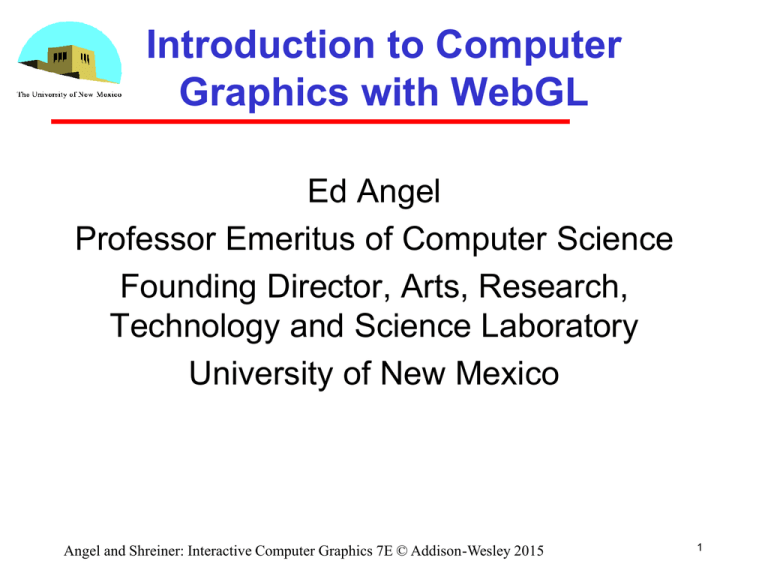
Introduction to Computer
Graphics with WebGL
Ed Angel
Professor Emeritus of Computer Science
Founding Director, Arts, Research,
Technology and Science Laboratory
University of New Mexico
Angel and Shreiner: Interactive Computer Graphics 7E © Addison-Wesley 2015
1
Video 1.3
• Example: Draw a triangle
- Each application consists of (at least) two files
- HTML file and a JavaScript file
• HTML
- describes page
- includes utilities
- includes shaders
• JavaScript
- contains the graphics
Angel and Shreiner: Interactive Computer Graphics 7E © Addison-Wesley 2015
2
Coding in WebGL
• Can run WebGL on any recent browser
- Chrome
- Firefox
- Safari
- IE
• Code written in JavaScript
• JS runs within browser
- Use local resources
Angel and Shreiner: Interactive Computer Graphics 7E © Addison-Wesley 2015
3
Example: triangle.html
Angel and Shreiner: Interactive Computer Graphics 7E © Addison-Wesley 2015
4
Example Code
<!DOCTYPE html>
<html>
<head>
<script id="vertex-shader" type="x-shader/x-vertex">
attribute vec4 vPosition;
void main(){
gl_Position = vPosition;
}
</script>
<script id="fragment-shader" type="x-shader/x-fragment">
precision mediump float;
void main(){
gl_FragColor = vec4( 1.0, 0.0, 0.0, 1.0 );
}
</script>
Angel and Shreiner: Interactive Computer Graphics 7E © Addison-Wesley 2015
5
HTML File (cont)
<script type="text/javascript" src="../Common/webgl-utils.js"></script>
<script type="text/javascript" src="../Common/initShaders.js"></script>
<script type="text/javascript" src="../Common/MV.js"></script>
<script type="text/javascript" src="triangle.js"></script>
</head>
<body>
<canvas id="gl-canvas" width="512" height="512">
Oops ... your browser doesn't support the HTML5 canvas element
</canvas>
</body>
</html>
Angel and Shreiner: Interactive Computer Graphics 7E © Addison-Wesley 2015
6
JS File
var gl;
var points;
window.onload = function init(){
var canvas = document.getElementById( "gl-canvas" );
gl = WebGLUtils.setupWebGL( canvas );
if ( !gl ) { alert( "WebGL isn't available" );
}
// Three Vertices
var vertices = [
vec2( -1, -1 ),
vec2( 0, 1 ),
vec2( 1, -1 )
]; Angel and Shreiner: Interactive Computer Graphics 7E © Addison-Wesley 2015
7
JS File (cont)
// Configure WebGL
//
gl.viewport( 0, 0, canvas.width, canvas.height );
gl.clearColor( 1.0, 1.0, 1.0, 1.0 );
// Load shaders and initialize attribute buffers
var program = initShaders( gl, "vertex-shader", "fragment-shader" );
gl.useProgram( program );
// Load the data into the GPU
var bufferId = gl.createBuffer();
gl.bindBuffer( gl.ARRAY_BUFFER, bufferId );
gl.bufferData( gl.ARRAY_BUFFER, flatten(vertices), gl.STATIC_DRAW
);
8
Angel and Shreiner: Interactive Computer Graphics 7E © Addison-Wesley 2015
JS File (cont)
// Associate out shader variables with our data buffer
var vPosition = gl.getAttribLocation( program, "vPosition" );
gl.vertexAttribPointer( vPosition, 2, gl.FLOAT, false, 0, 0 );
gl.enableVertexAttribArray( vPosition );
render();
};
function render() {
gl.clear( gl.COLOR_BUFFER_BIT );
gl.drawArrays( gl.TRIANGLES, 0, 3 );
}
Angel and Shreiner: Interactive Computer Graphics 7E © Addison-Wesley 2015
9
Exercise
• Run triangle.html from the class website
• Load the triangle.html and triangle.js to
your computer and run them from there
• Edit the two files to change the color and
display more than one triangle
Angel and Shreiner: Interactive Computer Graphics 7E © Addison-Wesley 2015
10
JavaScript Notes
• JavaScript (JS) is the language of the
Web
- All browsers will execute JS code
- JavaScript is an interpreted object-oriented
language
• References
- Flanagan, JavaScript: The Definitive Guide,
O’Reilly
- Crockford, JavaScript, The Good Parts, O’Reilly
- Many Web tutorials
Angel and Shreiner: Interactive Computer Graphics 7E © Addison-Wesley 2015
11
JS Notes
• Is JS slow?
- JS engines in browsers are getting much faster
- Not a key issues for graphics since once we get
the data to the GPU it doesn’t matter how we
got the data there
• JS is a (too) big language
- We don’t need to use it all
- Choose parts we want to use
- Don’t try to make your code look like C or Java
Angel and Shreiner: Interactive Computer Graphics 7E © Addison-Wesley 2015
12
JS Notes
• Very few native types:
- numbers
- strings
- booleans
• Only one numerical type: 32 bit float
- var x = 1;
- var x = 1.0; // same
- potential issue in loops
- two operators for equality == and ===
• Dynamic typing
Angel and Shreiner: Interactive Computer Graphics 7E © Addison-Wesley 2015
13
Scoping
• Different from other languages
• Function scope
• variables are hoisted within a function
- can use a variable before it is declared
• Note functions are first class objects in JS
Angel and Shreiner: Interactive Computer Graphics 7E © Addison-Wesley 2015
14
JS Arrays
• JS arrays are objects
- inherit methods
- var a = [1, 2, 3];
is not the same as in C++ or Java
- a.length // 3
- a.push(4); // length now 4
- a.pop(); // 4
- avoids use of many loops and indexing
- Problem for WebGL which expects C-style arrays
Angel and Shreiner: Interactive Computer Graphics 7E © Addison-Wesley 2015
15
Typed Arrays
JS has typed arrays that are like C arrays
var a = new Float32Array(3)
var b = new Uint8Array(3)
Generally, we prefer to work with standard
JS arrays and convert to typed arrays only
when we need to send data to the GPU
with the flatten function in MV.js
Angel and Shreiner: Interactive Computer Graphics 7E © Addison-Wesley 2015
16
A Minimalist Approach
• We will use only core JS and HTML
- no extras or variants
• No additional packages
- CSS
- JQuery
• Focus on graphics
- examples may lack beauty
• You are welcome to use other variants as
long as I can run them from your URL
Angel and Shreiner: Interactive Computer Graphics 7E © Addison-Wesley 2015
17
